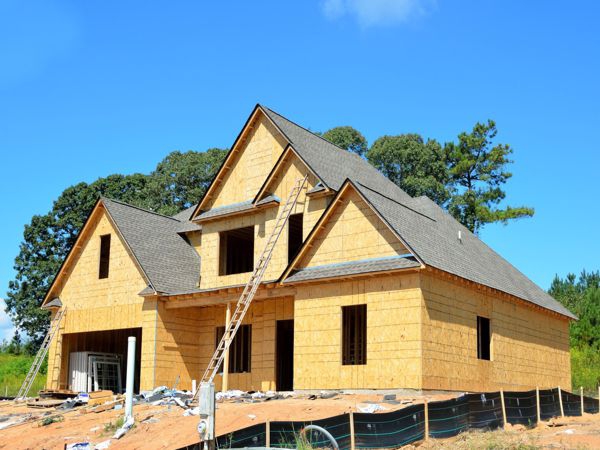US Home Supply Is Increasing, Higher Construction Costs Could Keep Prices Elevated
Aug. 23, 2021
Nationwide inventory recently began to increase after a multi-year downtrend. Higher building products costs and a tight labor market could keep home prices elevated.

Home Price Gains Are Greater Than The 2005/2006 Housing Bubble Peak
US Home Prices have risen rapidly over the past 12 months due to a variety of factors including, low-interest rates, shortage of available housing, and a robust economy following pandemic-related fiscal stimulus. The Case-Shiller Home Price Index rose 17% year over year in May 2021, surpassing the prior 2005/06 housing market boom peak of 15% in September 2005. Nationwide home prices are now 38% above the prior peak.
Many people have stated that we are currently experiencing a second housing bubble. It's possible, but the drivers of this cycle are different than the housing market in 2005/06. The prior cycle was driven by speculative lending and creative financing by banks - these facts are well-known and reported. This cycle is much different - lending is aggressive but not overly speculative. Last time we checked, we did not see five back-to-back TV shows about people quitting their jobs to flip homes and make a small fortune.
This cycle's boom is driven by supply and demand rather than speculative gambling. Supply is tight, and demand is high. The pandemic caused a whiplash in our economy - at the onset of the pandemic, there was prolonged uncertainty and many businesses delayed plans, laid-off workers, and cut back spending. Governments worldwide responded with generous fiscal stimulus to reignite economic growth - the stimulus worked, but the economy still experienced a six-month window of lower activity and production. As a result, we have consumers flush with stimulus cash and a reduced supply of goods... the combination of the two has led to shortages in many different industries.

Source: Federal Reserve and Case-Shiller
Takeaway: Home prices are 38% above the prior peak, and the growth rate of +17% in May 2021 surpassed the prior cycle peak growth rate of +15%
Long-term home prices are determined by affordability - which is essentially how much an average worker can pay each month. Affordability is determined by wages and interest rates (the cost to borrow money to get a loan). Higher wages and lower interest rates increase the amount a buyer can spend each month on a mortgage (home prices go up), while lower wages and higher interest rates decrease that amount (home prices go down).
Average wages increased by about +5% year-over-year in 2020, which is far below the current home price gain of +17%. Long-term, this difference is not sustainable - home prices can go up only so much before it becomes unaffordable for the marginal buyer. Wages will have to go up much more, or home prices will have to moderate while wages catch up.
Home Price Increases This Cycle Are Not As Speculative - It's More About Supply And Demand
Earlier this year, Emily Badger and Quoctrung Bui of the New York Times wrote a widely-cited article, Where Have All the Houses Gone?, featuring data gathered by Altos Research showing a dramatic drop in inventory of homes for sale. Inventory of condos, townhouses and single-family homes for sale hit the lowest level since Altos began collecting data. Supply hovered around 1.0-1.2 million in 2015/2016, then gradually decreased through 2019. Supply fell at a sharper pace when the pandemic began as builders shelved plans and took a "wait and see approach" given economic uncertainty. Currently, inventory is 50% below normal, which is a large housing shortage relative to history.

Source: Altos Research
Takeaway: US inventory of homes for sale is ~50% below normal levels as of August 2021
Altos Research's August update noted the tight supply trends are moderating. "This week we're seeing real estate inventory continue to climb and demand pull back a bit, with more homes taking price reductions, and fewer immediate sales," wrote Mike Simonsen. "Some things to note about our rising inventory levels: 2.5% in and of itself is not an alarming change. It’s pretty common. Inventory is still 50% below normal. My friend Ryan Lundquist, an appraiser in Sacramento, said it this way: 'A car going 100 mph down the highway and you take your foot off the gas, is rapidly decelerating and it’s still going really really fast. Both things can be true at the same time.' That’s really the right way to look at it."
Demand is strong as the economy continues to absorb fiscal stimulus distributed during the height of the pandemic. Rich Barton, Zillow Co-Founder and CEO stated on the Company's second quarter earnings call, "We believe there is strong durable support for the housing market. Historically work and location have been inextricably bound together. The pandemic has jolting and dramatically unbundled work from location for many, creating a new flexibility by enabling people to optimize for work and location separately and simultaneously. Moving to the big city is no longer a requirement for many job seekers and that shift will inevitably disperse talent and economic opportunities. This untethering of location from work fields deeply important to me for the future of work and life and by implication housing, what we’ve been calling the great reshuffling."
Building Materials & Labor Costs Are Rising
Input costs are rising, and inflation is back - this is no secret if you visit a grocery or hardware store on a regular basis. NAHBNow published a great post on the rising residential construction costs, noting that overall building costs have risen 19% over the past 12 months. The year-to-date change in residential construction costs between 2015 and 2020 on average was below 2%; however, in 2021 the year-to-date construction cost increased over 12% (19% year-over-year).

Source: NAHBNow and Bureau of Labor Statistics
Companies are seeing their input prices increase too, and for many, it is a much greater degree. Bank of America created the chart below showing how often the word "inflation" was mentioned by companies during their earnings calls. Second-quarter 2021 earnings saw a 1,100% increase year-over-year.
Source: Bank of America Research
Takeaway: Mentions of the word "inflation" during company earnings calls rose 1,100% year-over-year
Homebuilders are experiencing higher input costs for building materials, as well as shortages and shipment delays. Below is the change between December 2019 and August 2021 for several home construction inputs:
- Copper +56%
- Steel +44%
- Drywall +26%
- Lumber +17%
- Insulation +13%
- Asphalt +7%
- Labor +6%
Construction costs typically represent about 60% of a new home cost. When building material costs increase, this cost is passed along from the builder to the home buyer (it can take 6-12 months for the full cost to be passed along due to contract pricing and delays).
The National Association of Home Builders published its 2020 New Home Construction Survey last year, categorizing various cost components to build a home. Construction costs represent about 60% of a new home's price - this means that changes in construction costs have a meaningful impact on home prices medium and long-term.

Source: NAHB Cost of New Home Construction Survey

Source: NAHB Cost Of New Home Construction Survey
Takeaway: Construction costs are the largest component of a new home cost at ~60% of the purchase price. Builder profit margins are typically between 8-10%.
Our team at Equipment Radar created a helpful tool for you to model and forecast how various construction cost changes can impact the price of a new home. Visit our Airtable Interactive Spreadsheet here.
Higher input costs will ultimately raise the cost of a new home. It is reasonable to assume that a meaningful portion of recent home price gains can be attributable to higher building materials costs and replacement cost. Home prices could remain elevated if construction costs remain high.
Residential Construction Stands To Benefit
Construction companies and equipment dealers stand to benefit from the low nationwide supply of homes available for sale. We will need more equipment and machines to address the inventory situation. Also, construction companies will look to increase investment in automation and technology to increase productivity given labor market shortages.
Conclusion
The strong price gains in home prices may be stickier than the 2005/2006 cycle due to higher building costs and low inventory of homes available for sale. Home prices could take a "breather" and flatten out for some time - it seems that a drop similar to 2005/06 is less likely. Last, the post-pandemic world has changed - generous fiscal stimulus (checks in the mail from governments) will likely be utilized again at the first signs of any major slowdown.
Find Similar Articles By Topic
#construction #housing #transportation #inflation #real estate



